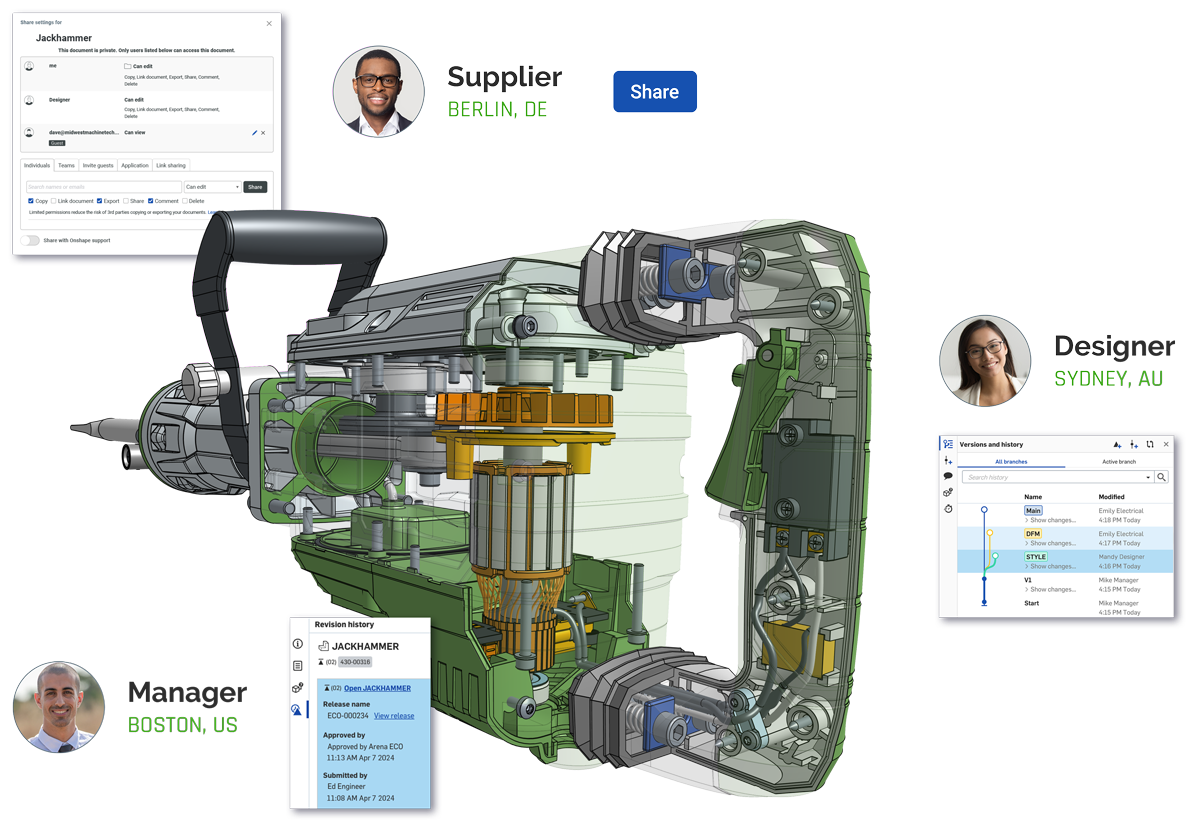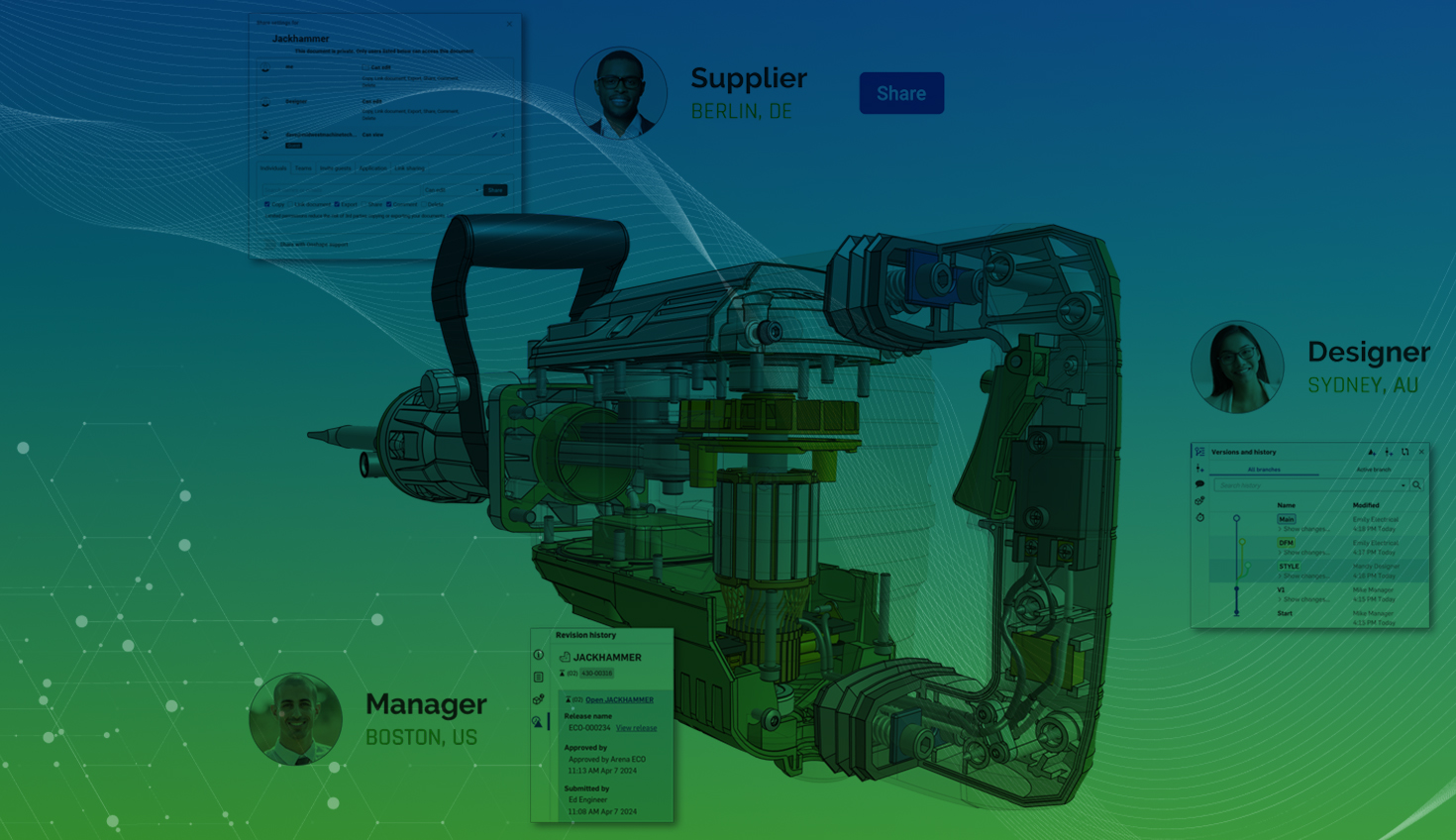Let’s be honest: anyone who’s been through design reviews and engineering changes knows they can be painfully inefficient.
Miscommunication, version control nightmares, and complex ECO processes can turn even the most straightforward projects into stressful ordeals. But do they have to be so difficult? Keep reading to understand and solve these pain points, saving you time, reducing stress, and leading to better products. Additionally, with PTC’s Onshape, learn how design reviews and releases become manageable.
Let’s dive into how you can make your collaborative design activities smoother and more efficient.
The Pain Points of Collaborative Design
Communication Silos
Effective communication is vital in any collaborative effort. In design reviews, poor communication can lead to misunderstandings, errors, and delays. Engineering teams often work in silos, using different tools and processes, which complicates the flow of information. The lack of a centralized communication platform exacerbates this issue, resulting in a fragmented understanding of the project.
Version Control Chaos
Managing multiple versions of design documents is a nightmare for many engineers. Without a robust version control system, teams can quickly lose track of the latest design iteration, leading to duplicated work, conflicting updates, and ultimately, costly errors. This chaos not only slows down the design process but also frustrates team members who struggle to find the most current information.
READ: Eliminating CAD Version Control Issues with Onshape’s Single Source of Truth
Inefficient Feedback Loops
Design reviews are meant to provide constructive feedback to improve the product. However, inefficient feedback loops often turn into a source of frustration. Feedback may be vague, delayed, or lost in the shuffle of emails and meeting notes. This inefficiency can cause rework, missed deadlines, and a decline in overall project quality.
Limited Access
With teams often spread across different locations and time zones, collaboration can be challenging. Differences in work hours, cultural nuances, and the lack of face-to-face interaction can hinder effective teamwork. Apart from the geographical hindrances, engineers also need access to the latest data and designs to make informed decisions. When information is scattered across various platforms or is difficult to retrieve, it can lead to outdated decisions and unnecessary rework.
READ: How Cloud-Native CAD Supports Flexible Work for the Summer
The Pain Points of Engineering Changes Complexity and Detail Overload
Engineering changes are inherently complex. They involve detailed documentation, multiple approvals, and coordination across various departments. The sheer volume of information and the number of stakeholders can make managing changes overwhelming. Ensuring that every detail is accurate and that all relevant parties are informed adds to the complexity.
Rework and Dependencies
Implementing changes often involves substantial rework, as engineers often revisit and validate design problems they believe were resolved. This rework is not only time-consuming but can be compounded by changes that have to be propagated to other parts of the product. What might initially seem like a minor adjustment can escalate significantly as interdependencies and tolerance stack-ups throughout the design are addressed.
Traceability Issues
Traceability is crucial in managing engineering changes. Being able to track the history of changes, approvals, and implementations is essential for accountability and quality assurance. However, many organizations struggle with maintaining a clear and accessible record of changes, which can result in confusion and errors.
How Onshape Solves These Problems

Enhancing Communication
Onshape offers a development platform where all stakeholders can collaborate in real time. It eliminates silos by providing a centralized communication hub, ensuring that everyone is on the same page. Onshape’s commenting and notification features improve collaboration, reducing misunderstandings and errors.
Streamlining Version Control
Onshape’s built-in PDM system ensures that all design changes are tracked and documented. Teams can easily access the latest design iterations, compare changes, and revert to any previous version if necessary. This robust version tracking prevents duplicated work and conflicting updates, making the design process smoother and more efficient.
Efficient Feedback Mechanisms
Onshape facilitates efficient feedback loops with its real-time collaboration tools. Using these tools, team members can provide specific, timely feedback directly within the platform. Onshape enables the review and approval of new designs to streamline the feedback process, ensuring that all comments are addressed promptly and accurately.
TECH TIP: How to Use Onshape’s Built-In Feedback Tool
Instant Access
Onshape supports asynchronous and synchronous collaboration, enabling team members across multiple time zones to work together effectively. Along with global accessibility, the cloud-native platform also provides instant access to the most current design data and documentation. Team members can retrieve up-to-date information at any time and anywhere in the world, reducing the risk of outdated decisions.
Simplifying ECO Processes
Onshape simplifies the complexity of engineering changes with automated workflows and detailed tracking. Its platform allows for easy creation, submission, and approval of ECOs ensuring that all stakeholders are informed and that changes are implemented efficiently. Onshape’s comprehensive audit trails enhance traceability, making it easy to track the history of changes and approvals.
READ: Using Cloud-Native CAD to Accelerate Product Innovation
Top to Bottom View
With Onshape’s Branching and Merging feature, engineers can create isolated environments to implement and test changes without disrupting the main design. This capability allows multiple ECOs to be worked on simultaneously, reducing bottlenecks. Onshape’s branch and merge functions enable easy review and integration of changes, ensuring that only the necessary modifications are applied. By providing a centralized, cloud-native platform, Onshape enhances collaboration, minimizes rework, and effectively manages the interdependencies and tolerance stack-ups that complicate the ECO process.
FEATURE HIGHLIGHT: Onshape's Branching and Merging
Enhancing Traceability
Onshape’s digital solutions offer detailed audit trails and change tracking, ensuring that all ECOs are documented and easily accessible. This traceability enhances accountability and quality assurance, reducing the risk of errors and ensuring that all changes are implemented correctly.
Revolutionizing Design Reviews and
Onshape is more than another CAD system; it eliminates the limits and inefficiencies restricting engineering teams during critical design reviews and processes. With its cloud-native architecture, Onshape empowers streamlined collaboration, transparent data trails, and accelerated design review cycles. The longstanding productivity bottlenecks that plague these activities are systematically removed.
In this era defined by continual digital disruption and transformation, the ability to accelerate design cycles and rapidly execute design reviews and s separates industry leaders from lagging competitors. Organizations can no longer afford to be constrained by the protracted inefficient processes and outdated legacy technologies that hinder these crucial product development tasks. The imperative now is to break free from the constraints of traditional on-premise CAD solutions.
Onshape’s cloud product development platform, with its advanced collaboration capabilities, is a better path forward.
The Onshape
Discovery Program
Learn how qualified CAD professionals
can get Onshape Professional
for up to 6 months – at no cost!

